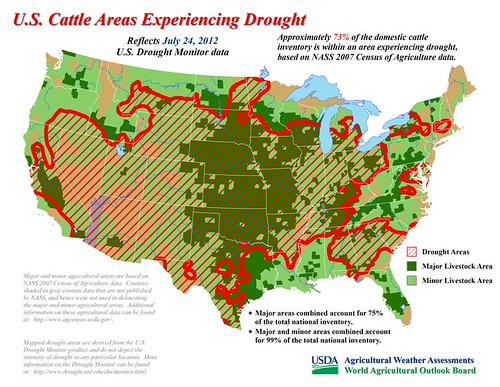
During the week ending July 24, 2012, the portion of the contiguous United States in drought inched upward to 64%, according to the U.S. Drought Monitor. The Drought of 2012 continues to hit some of the nation’s most important agricultural regions especially hard, with more than seven-eighths of the nation’s corn (89%) and soybeans (88%) considered to be within an area experiencing drought. In addition, more than one-third of both crops, 37% of the corn and 35% of the soybeans, are currently experiencing the two worst categories of drought – extreme to exceptional – designated by D3 and D4, respectively, on the Drought Monitor.
Drought is also having a profound effect in other agricultural sectors. For example, 73% of the nation’s domestic cattle inventory is within an area experiencing drought conditions. In addition, 66% of the U.S. hay acreage is being affected by drought.

Weather Outlook: Short-term prospects for drought relief are mixed at best. Extreme heat, which has been temporarily flushed from the Midwest, will return to the southern and western Corn Belt by early next week. Meanwhile, 100-degree heat will continue to plague the central and southern Plains and the Mid-South during the next several days. Although scattered showers will dot the Plains, Midwest, and Mid-South during the next five days, rainfall amounts will be an inch or less, except for locally higher amounts in thunderstorms. Therefore, no widespread drought relief can be expected in the nation’s heartland through the end of July.
